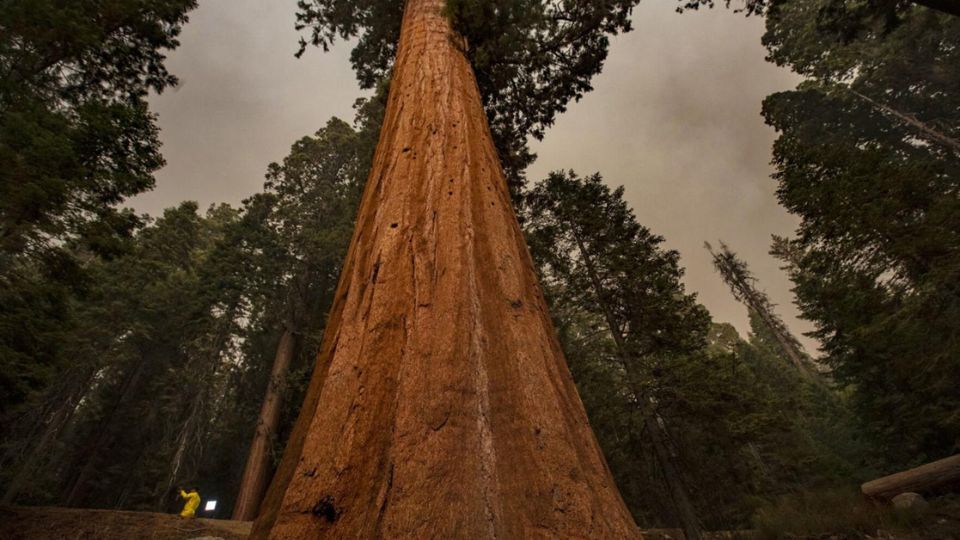Is fresh air necessary? Recent research reveals that air pollution impacts nearly all national parks. Additional issues are leading to an increase in the frequency and severity of wildfires in national parks. The sun shines on a cholla cactus in Joshua Tree National Park on Monday, May 25, 2020. According to a recent study, the park ranks as one of the top four most polluted in the country.
The sun shines on a cholla cactus in Joshua Tree National Park on Monday, May 25, 2020. According to a recent study, the park ranks as one of the top four most polluted in the country.
A few years back, Roberto Morales led a group of low-income Los Angeles area residents to Sequoia National Park as part of the Sierra Club’s Outdoors for All campaign to assist with a forest restoration project.
They intended to walk a few miles on the journey. However, Morales had to shorten the hike due to the park being very smoggy, which could potentially cause health problems for the volunteers.
“It was simply a teachable moment for us,” Morales stated. “Despite the beauty of these locations, pollution remains a persistent issue.”
According to a recent study by the National Parks Conservation Association, almost 97% of 399 important national park sites are facing high levels of human-caused ozone pollution. According to Mark Rose, a program manager for a nonprofit in California, air quality in parks can be worse than in nearby cities due to weather and geography.
California is home to the four U.S. parks with the most polluted air
Joshua Tree, Sequoia and Kings Canyon national parks and Mojave National Preserve often experience low air quality, which can be harmful to visitors, employees, and nearby residents, as well as the plants and animals living in these areas. Yosemite and Death Valley national parks are also among the top 10 locations with the most polluted air.
A climber jumps across rocks at Joshua Tree National Park on Monday, May 25, 2020. According to a recent study, the park ranks as one of the top four most polluted in the country.
Industrial, transportation, and agricultural pollution often results in hazy skies at these parks, which can obstruct views. These emissions contribute to global warming, which intensifies the challenges parks are dealing with, such as drought, wildfire, invasive species, and rising sea levels.
Luckily, Rose mentioned that there have been noticeable improvements in certain areas since the last “Polluted Parks” report was released in 2019. There are also actions individuals can take to continue the recent progress and preserve parks for future generations.
Meanwhile, Rose suggested some basic measures to safeguard our health while visiting these locations, allowing everyone to enjoy some of the most breathtaking natural wonders on Earth.
Also Read: California officer shoots and kills 15 year old boy, holding gardening tool
Visitors are impacted more by pollution
In the most recent report from the National Parks Conservation Association (NPCA), the percentage of parks facing “significant” air pollution problems decreased from 96% in 2019 to 70%. Regrettably, Rose mentioned that California parks have not experienced similar enhancements.
It ultimately depends on the source of the pollution. “In certain states, there are national parks affected by one or two large coal-fired power plants causing significant pollution,” Rose explained. If controls are implemented or those plants are retired, significant benefits will be observed. “California has numerous sources of pollution, making it a challenging situation for the state,” he added. “We need to persist and pursue various sources.”
Southern California often faces the nation’s most severe air pollution due to emissions from oil refineries and the ports of Los Angeles and Long Beach. Originating from trucking corridors and large warehouses across the Inland Empire. It also originates from challenging-to-decarbonize business sectors, like cement manufacturing plants in the high desert and airports throughout the region.
These pollution sources are leading to higher rates of asthma in children, as ozone can inflame and irritate the lungs. Increased risks of preterm births, certain cancers, and diabetes are being heightened for individuals residing in communities with higher pollution levels, particularly affecting people of color and low-income groups.
Although national park boundaries are clearly defined on a map, air pollution can easily travel long distances into these protected areas. It gets trapped and concentrated in the valleys of the parks, then gradually moves into the foothills and mountains. That is why there have been years when air monitors in Sequoia and Kings Canyon indicated that ozone violations were more frequent in national parks than in Los Angeles.
For Morales, whose group is dedicated to assisting residents in escaping the smog by connecting them with nature, it is becoming increasingly challenging to locate areas that provide genuine relief.



Leave a Reply